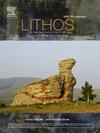Granitoids from St. Martin/Maarten Island, Caribbean: Insights on the role of mantle processes in the Lesser Antilles arc
IF 2.9
2区 地球科学
Q2 GEOCHEMISTRY & GEOPHYSICS
引用次数: 0
Abstract
The granitoids in St. Martin Island, Lesser Antilles – Caribbean, consist of granodiorites (Type-I low REE; Type-II high REE), leucotonalites, melatonalites and Qz-monzodiorites. These are I-type calc-alkaline granitoids, although classification of the newly identified melatonalites remains enigmatic, likely reflecting magma mixing between different sources for their formation. Geothermometry applications yield high formation temperatures for the melatonalites and the Type-II granodiorites exceeding by ∼100 °C those calculated for the other granitoids. Pressure conditions were relatively high for the melatonalites and granodiorites (∼4.2 and ∼ 4.0 kbar respectively), with the lowest assigned to the leucotonalites (∼1.8 kbar). Magnesiohornblende crystallized at the final crystallization stages (∼740 °C; ∼2.5 km depth), under hydrous (H2O = ∼3.5 wt%) and highly oxidizing conditions (ΔNNO up to +2.7).
Fractional crystallization significantly contributed to the compositional variability of the evolved granitoid lithotypes, with plagioclase being preferably fractionated in the Type-I granodiorites, relative to the Type-II granodiorites that mostly involved K-feldspar removal. Additionally, fluctuation of the hydrous and slab-derived fluid fluxes further promoted granitoid differentiation. Geochemical and Sr-Nd isotopic data reveal restricted sediment contamination of the mantle wedge. Melatonalites and Type-II granodiorites appear to have been formed during the early evolution stages of subduction initiation, whereas leucotonalites represent the late-stage shallow crystallization granitoid phase.
求助全文
约1分钟内获得全文
求助全文
来源期刊

Lithos
地学-地球化学与地球物理
CiteScore
6.80
自引率
11.40%
发文量
286
审稿时长
3.5 months
期刊介绍:
Lithos publishes original research papers on the petrology, geochemistry and petrogenesis of igneous and metamorphic rocks. Papers on mineralogy/mineral physics related to petrology and petrogenetic problems are also welcomed.
 求助内容:
求助内容: 应助结果提醒方式:
应助结果提醒方式:


